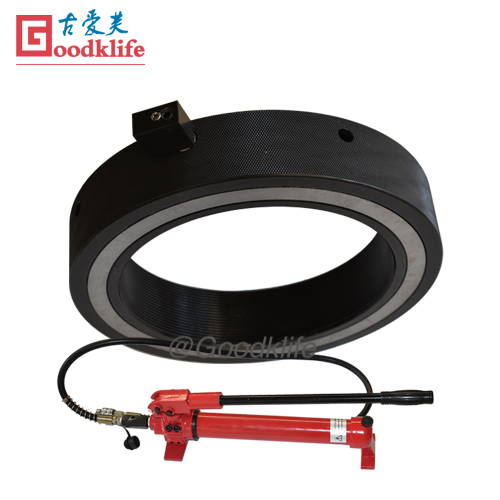What are the precautions when using hydraulic nuts?
Views : 2683
Author : Yuan Feng
Update time : 2021-03-19 11:30:00
1. It must be noted that the thread directions of the inner holes of the upper and lower shafts are different.
2. For hydraulic nuts operated by an oil or grease pump, the accuracy of the clearance between the knives can be adjusted to a certain extent. This has some effect on tools with poor flatness, but this effect is very limited and requires extremely rich experience. For this kind of pump, the pressure should not be too large, otherwise it will cause damage to the knife shaft.
3. For the hydraulic nut that uses a rotating screw to push the small piston, you must pay attention to its working position: Is the small screw already screwed to the end, or is the pressure from tooling too large to screw it? The operator must be able to distinguish. If the former is regarded as the latter, it will not be able to give full play to the due role of precision knives. There are two problems here:
a. The compression flow of this small piston is very small, not enough to push the entire seal ring to the necessary displacement when pressing the tool, so that the screw has been screwed to the end and it is mistaken for the pressure to be fully applied.
b. The most precise tool also has flatness errors, even if its parallelism is very good, especially for thin spacers with a thickness of less than 2 mm, the tool supplier only guarantees that the parallelism is about 0.002 mm, and the flatness is below 0.02 mm . If more thin spacers are used, there will be a large original error.
Here is an example to illustrate this problem:
The cutter shaft is 1800 mm long, and 42 strips are cut, each with two thin spacers less than 2 mm, totaling 80 pieces. Their unevenness is also in the middle value of 0.01 mm, so its original cumulative error is 0.8 mm. If the diameter of the sealing ring of the hydraulic nut is 200 mm and the ring width is 10 mm, then the flow required for it to move 0.8 mm in the axial direction (which is already a very small displacement) is: 20 x 3.14 x 1 x 0.08 = 5 cm³. However, the compression flow rate that a small piston can produce is at most 2.5 cm³, which is not enough for the sealing ring to move a distance of 0.8 mm, which creates an illusion for the operator. The problem was solved immediately after the plant was changed to pressure with a grease pump under the author's suggestion.
2. For hydraulic nuts operated by an oil or grease pump, the accuracy of the clearance between the knives can be adjusted to a certain extent. This has some effect on tools with poor flatness, but this effect is very limited and requires extremely rich experience. For this kind of pump, the pressure should not be too large, otherwise it will cause damage to the knife shaft.
3. For the hydraulic nut that uses a rotating screw to push the small piston, you must pay attention to its working position: Is the small screw already screwed to the end, or is the pressure from tooling too large to screw it? The operator must be able to distinguish. If the former is regarded as the latter, it will not be able to give full play to the due role of precision knives. There are two problems here:
a. The compression flow of this small piston is very small, not enough to push the entire seal ring to the necessary displacement when pressing the tool, so that the screw has been screwed to the end and it is mistaken for the pressure to be fully applied.
b. The most precise tool also has flatness errors, even if its parallelism is very good, especially for thin spacers with a thickness of less than 2 mm, the tool supplier only guarantees that the parallelism is about 0.002 mm, and the flatness is below 0.02 mm . If more thin spacers are used, there will be a large original error.
Here is an example to illustrate this problem:
The cutter shaft is 1800 mm long, and 42 strips are cut, each with two thin spacers less than 2 mm, totaling 80 pieces. Their unevenness is also in the middle value of 0.01 mm, so its original cumulative error is 0.8 mm. If the diameter of the sealing ring of the hydraulic nut is 200 mm and the ring width is 10 mm, then the flow required for it to move 0.8 mm in the axial direction (which is already a very small displacement) is: 20 x 3.14 x 1 x 0.08 = 5 cm³. However, the compression flow rate that a small piston can produce is at most 2.5 cm³, which is not enough for the sealing ring to move a distance of 0.8 mm, which creates an illusion for the operator. The problem was solved immediately after the plant was changed to pressure with a grease pump under the author's suggestion.



